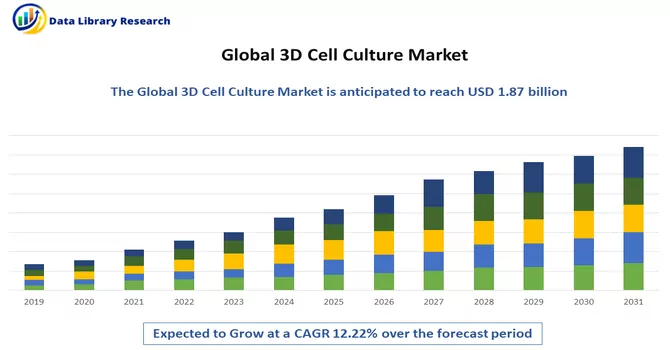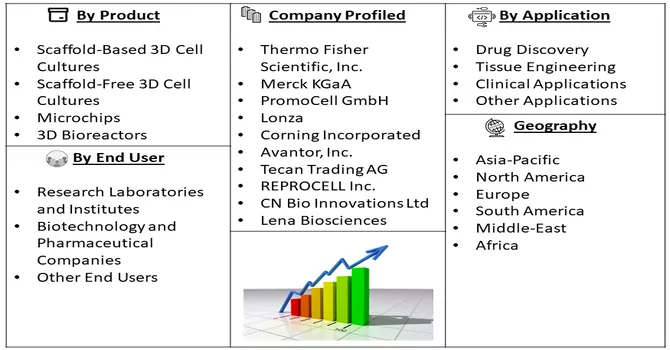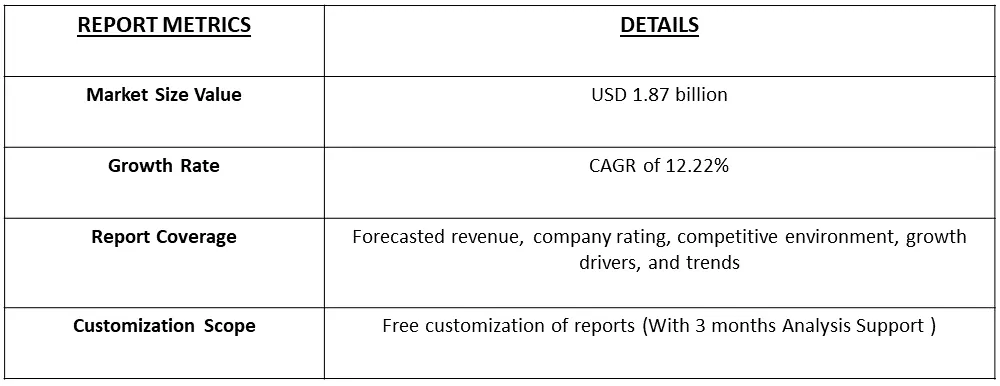The global 3D cell culture market size was estimated at USD 1.87 billion in 2023 and is expected to expand at a compound annual growth rate (CAGR) of 12.22% from 2024 to 2031.

Get Complete Analysis Of The Report - Download Free Sample PDF
The 3-D cell market pertains to the sector dedicated to advancing three-dimensional cell culture technologies, which revolutionize the cultivation and examination of cells by providing a more physiologically relevant environment compared to traditional two-dimensional cultures. This expansive market encompasses a diverse array of products and services, including 3-D cell culture scaffolds, bioreactors, and assays, all designed to facilitate the growth and analysis of cells within three-dimensional structures.
The adoption of 3-D cell culture methodologies has gained significant traction across various scientific disciplines, particularly in drug discovery, regenerative medicine, and cancer research. This approach offers a more nuanced understanding of cellular behaviour and tissue development, leading to more accurate and predictive biomedical studies. Several factors contribute to the burgeoning growth of the 3-D cell market. One key driver is the increasing efforts to develop viable alternatives to animal-based testing. The limitations associated with animal models, such as lack of response accuracy and variations in responses among different species, have prompted a shift towards more sophisticated 3-D cell culture techniques as a means to address these challenges. Funding programs supporting research initiatives also play a pivotal role in propelling the market forward. The availability of financial support encourages innovation and the development of advanced technologies in the field of 3-D cell culture. Additionally, the consistent investment in research and development activities by biopharmaceutical companies, specifically in the realm of drug development and discovery, contributes significantly to market expansion.
Moreover, there is a growing emphasis on the adoption of 3D cell cultures in cancer research. The three-dimensional environment more closely mimics the complex conditions within living organisms, offering researchers a more accurate representation of how cancer cells behave and respond to treatments. This has led to an increased acceptance of 3-D cell cultures as a valuable tool in the study of cancer biology. In conclusion, the 3-D cell market is experiencing substantial growth driven by the quest for alternatives to animal testing, financial support for research endeavors, and the increasing recognition of the advantages offered by three-dimensional cell culture in advancing biomedical studies, particularly in drug discovery and cancer research. As technology continues to evolve, the market is poised to play a pivotal role in shaping the future of cellular research and therapeutic development.
The 3D Cell Culture Market, while experiencing significant growth, faces several restraints. High initial costs associated with acquiring and implementing advanced equipment pose a barrier, particularly for smaller research institutions. The complexity of 3D cell culture techniques requires specialized knowledge, hindering widespread adoption. Standardization challenges and the limited availability of specialized reagents affect the reliability and reproducibility of experiments. Regulatory hurdles in meeting evolving standards for drug approval and longer experimentation times further impede progress. Compatibility issues with high-throughput screening and ethical concerns regarding the shift away from animal testing also present challenges. Additionally, a lack of market awareness and understanding in some research segments requires targeted education initiatives to promote the advantages and methodologies of 3D cell culture. Addressing these restraints is crucial for the broader acceptance and sustained growth of 3D cell culture technologies across scientific disciplines.
Market Segmentation: The 3D Cell Culture Market is Segmented by Product (Scaffold-Based 3D Cell Cultures, Scaffold-Free 3D Cell Cultures, Microchips, and 3D Bioreactors), Application (Drug Discovery, Tissue Engineering, Clinical Applications, and Other Applications), End User (Research Laboratories and Institutes, Biotechnology and Pharmaceutical Companies, and Other End Users), and Geography (North America, Europe, Asia-Pacific, Middle-East and Africa, and South America). The value is provided (in USD million) for the above segments.

For Detailed Market Segmentation - Download Free Sample PDF
Market Drivers:
Increasing demand for organ transplantation & tissue engineering
The 3D cell culture market is experiencing consistent growth, propelled by several key factors. The adoption of 3D cell culture models as alternative tools for in vivo testing is a major driver, offering a more physiologically relevant environment compared to traditional 2D cell cultures. This shift is particularly valuable in drug safety and efficacy assessment, as 3D models mimic in vivo conditions more accurately. Importantly, these models address the challenge of species differences, providing a more reliable interpretation of preclinical outcomes by enabling drug testing directly in human systems. The development of large-scale automated cell culture systems is another contributing factor to the market's stability. Automation enhances efficiency, scalability, and reproducibility in 3D cell culture processes, making them more attractive for pharmaceutical and biotechnology industries engaged in drug discovery and development. A significant driver for the 3D cell culture market is the escalating demand for organ transplantation. The benefits of 3D cell culture and co-culture models extend beyond drug testing, as they play a crucial role in recapitulating complex aspects of human physiology, pathology, and drug responses in vitro. This becomes especially pertinent in the context of organ transplantation, where there is a pressing need to develop research models that accurately represent the intricacies of human systems.
According to data from the United States Health Resources and Services Administration, as of October 2021, 107,103 patients were on the national organ transplant waiting list in the year 2020. With approximately 39,000 organ transplants conducted annually in the United States, the demand for research models, particularly those involving 3D cell cultures, is expected to rise. The need to address the challenges associated with organ transplantation, such as organ shortage and compatibility issues, further underscores the significance of 3D cell culture technologies in advancing research and therapeutic development. Thus, the 3D cell culture market's steady growth is fueled by the increasing recognition of its benefits in drug testing, the development of automated systems, and the rising demand for solutions in the field of organ transplantation. These factors collectively contribute to the market's positive trajectory and underscore its vital role in advancing biomedical research and healthcare.
Increasing focus on developing alternatives to animal testing
There is a notable surge in efforts to develop alternatives to animal testing, accompanied by a parallel emphasis on advancing 3D cell culture technologies. This dual focus stems from ethical concerns, scientific advancements, and the quest for more reliable testing methods. The move towards alternatives, such as advanced cell culture techniques and organ-on-chip technologies, aims to replace traditional animal models with more humane and predictive in vitro approaches. Simultaneously, the burgeoning interest in 3D cell culture underscores the pursuit of physiological relevance in experimental models. The convergence of these trends signifies a broader commitment to ethical research practices, regulatory compliance, and the quest for more accurate, cost-effective, and scalable methodologies in various industries, including pharmaceuticals and toxicology. As these developments progress, they collectively contribute to a transformative shift towards innovative, ethically responsible, and scientifically robust approaches in biomedical research.
Market Restraints:
High cost associated with implementation
A significant obstacle in the 3-D cell market revolves around the intricacy and expenses associated with implementing and sustaining three-dimensional cell culture systems. The integration of these advanced technologies demands specialized equipment, expertise, and infrastructure, resulting in elevated initial investments and ongoing operational costs for research institutions and biotechnology companies. Beyond financial considerations, the complexities involved in optimizing 3-D cell cultures for specific applications present challenges that hinder widespread adoption. The nuanced nature of these systems can pose technical barriers, limiting accessibility and adoption, particularly for smaller research laboratories or organizations constrained by limited resources. Consequently, the cumulative impact of high costs and technical challenges may constrain the broader market penetration of 3-D cell culture technologies, impeding their potential to revolutionize research methodologies across diverse scientific domains.
The COVID-19 pandemic is anticipated to exert a substantial influence on the market, particularly due to the imperative role of 3D cell cultures in advancing research related to the virus. Scientists engaged in COVID-19 studies find 3D cell cultures indispensable, especially when investigating relevant matrices suitable for air-liquid interface culture. These cultures enable in vitro exploration of the mechanisms underlying the systemic consequences of the virus and facilitate the testing of potential therapies within a physiological microenvironment. The significance of 3D cell cultures in COVID-19 research is underscored by a March 2021 article in Frontiers Online titled "3D Tissue Models as an Effective Tool for Studying Viruses and Vaccine Development." The article highlights the advantages of employing 3D tissue culture techniques over traditional 2D approaches when studying viral infections, particularly in the context of COVID-19. Notably, the study points out that techniques such as organoids and spheroid cultures demonstrate a higher fidelity in replicating systems of viral infection compared to 2D cultures. These 3D cultures exhibit the morphology and biochemical behaviors necessary to accurately simulate viral infection scenarios, which might be challenging to achieve with 2D cultures. As the scientific community grapples with the complexities of understanding and combatting COVID-19, the utilization of 3D cell cultures emerges as a pivotal tool, offering a more nuanced and physiologically relevant platform for studying the virus and advancing potential therapeutic interventions.
Segmental Analysis:
The Microchips Segment is Expected to see Significant Growth Rate Over the Forecast Period
Microchips, also referred to as organ-on-a-chip or microsystems, seamlessly integrate microfluidic technologies with 3D cell culture within microfabricated devices, leveraging techniques from the microchip industry. A study published in Analytical Methods in June 2019 showcased a microchip's ability to separate and detect dopamine and norepinephrine release in real time, emphasizing their crucial role in advancing neurotransmitter analysis. Meanwhile, traditional 2D culture and animal models, commonly used in research, fall short in replicating the complexity of human tissue physiology, driving the adoption of organs-on-a-chip (OoCs) for more accurate in vivo response predictions during drug development. The cost-effectiveness of microchips, facilitating testing across a wide range of medicine concentrations, is expected to drive demand and accelerate scientific research. Innovations like SpaceX's incorporation of microchips with living human cells for physiological modelling further highlight the transformative potential of this technology, reinforcing the projection that 3D cell culture technologies, integrated with microchips, will drive significant growth in the market.
Tissue Engineering Segment is Expected to see Significant Growth Rate Over the Forecast Period
Tissue engineering and 3D cell culture represent intertwined frontiers in biomedical research, redefining approaches to regenerative medicine and in vitro studies. Tissue engineering applies engineering principles to create functional artificial tissues for transplantation or therapeutic use, and the integration of 3D cell culture is pivotal in achieving this goal. Unlike traditional 2D cultures, 3D cell culture techniques enable the development of a more physiologically relevant environment, closely mimicking native tissue architecture. This is particularly crucial for tissue engineering, where precision in replicating the intricate structure and function of natural organs is paramount. The marriage of 3D cell culture and tissue engineering enhances the viability and functionality of engineered tissues, employing scaffolds designed with advanced fabrication techniques. Beyond tissue fabrication, this synergy holds significant implications for drug discovery, allowing researchers to study complex cellular interactions and disease progression in a controlled setting, thereby advancing personalized medicine and therapeutic interventions. As these fields continue to evolve, the collaborative efforts of tissue engineering and 3D cell culture promise groundbreaking advancements in regenerative medicine and biomedical research.
Pharma and Biotech Companies Segment is Expected to see Significant Growth Rate Over the Forecast Period
Pharmaceutical and biotechnology companies are embracing the transformative potential of 3D cell culture technologies in their research and development endeavours. This shift represents a paradigm change in drug discovery, enabling a more accurate and physiologically relevant understanding of cellular behaviour and disease mechanisms compared to conventional 2D cell cultures. By recreating three-dimensional tissue-like structures, these technologies offer a realistic platform for screening drug candidates, assessing efficacy, and evaluating safety profiles, ultimately expediting early-stage drug development. Particularly prevalent in biotech companies, the incorporation of 3D cell culture enhances experimental sophistication, contributing to faster and more informed decision-making processes. Moreover, the adoption of 3D cell culture aligns with the industry's move towards personalized medicine, allowing for tailored drug development based on patient-derived cells, and fostering the creation of more targeted and effective therapeutics. As pharmaceutical and biotech companies increasingly integrate 3D cell culture into their workflows, the approach not only refines preclinical studies but also aligns with ethical considerations and cost-effectiveness, marking a progressive shift towards innovative and reliable drug development practices.
North America Region is Expected to see Significant Growth Rate Over the Forecast Period
North America emerges as a driving force in the expanding 3D cell culture market, marked by a robust presence of leading pharmaceutical and biotechnology entities, advanced research institutions, and a supportive regulatory framework. In the United States and Canada, the adoption of 3D cell culture technologies is gaining momentum in drug development, with a focus on providing more physiologically relevant insights compared to traditional models. The region's commitment to innovation is evident in significant investments, research initiatives, and collaborative efforts between academia and industry, positioning North America at the forefront of biomedical advancements. Ethical considerations, coupled with the demand for more predictive research models, further contribute to the growing popularity of 3D cell culture technologies in the region, reinforcing its pivotal role in reshaping drug discovery, disease modeling, and therapeutic development practices.

Get Complete Analysis Of The Report - Download Free Sample PDF
The 3D cell culture market is characterized by intense competition and is primarily led by a handful of major players that hold significant market share. These key industry participants play a pivotal role in shaping the dynamics of the market, driving innovation, and influencing the overall direction of advancements in 3D cell culture technologies. As competition continues to intensify, these major players are actively involved in strategic initiatives, research and development efforts, and collaborations to maintain and expand their market presence. The competitive landscape underscores the importance of continuous innovation and strategic partnerships as key factors for success in this dynamic and evolving market. Financials, strategy maps & products of these 3D cell culture companies are analyzed to map the supply network.
Recent Development:
1) In August 2021, Amerigo Scientific expanded its array of cell culture offerings by introducing a novel 3D Cell Culture system tailored for scientific applications. This innovative system, designed for applications in drug discovery, medicine, nanomaterial evaluation, and basic life science research, enhances Amerigo Scientific's portfolio to cater to diverse scientific needs.
2) In January 2021, Jellagen Limited, a biotechnology firm specializing in manufacturing high-value Collagen Type 0 derived from jellyfish, unveiled its latest product, JellaGel Hydrogel. Functioning as a 3D hydrogel, JellaGel offers researchers a non-mammalian, natural, biochemically straightforward, consistent, and user-friendly hydrogel, presenting a transformative option for their research endeavours. These developments underscore the continuous innovation within the 3D cell culture market, providing researchers with advanced tools for various scientific disciplines.
Q1. What was the 3D Cell Culture Market size in 2023?
As per Data Library Research the global 3D cell culture market size was estimated at USD 1.87 billion in 2023.
Q2. What is the Growth Rate of the 3D cell culture Market ?
3D cell culture Market is expected to expand at a compound annual growth rate (CAGR) of 12.22% Over the forecast period.
Q3. What are the factors driving the 3D cell culture market?
Key factors that are driving the growth include the Increasing demand for organ transplantation & tissue engineering and Increasing focus on developing alternatives to animal testing.
Q4. Who are the key players in 3D cell culture market?
Some key players operating in the market include
Data Library Research are conducted by industry experts who offer insight on industry structure, market segmentations technology assessment and competitive landscape (CL), and penetration, as well as on emerging trends. Their analysis is based on primary interviews (~ 80%) and secondary research (~ 20%) as well as years of professional expertise in their respective industries. Adding to this, by analysing historical trends and current market positions, our analysts predict where the market will be headed for the next five years. Furthermore, the varying trends of segment & categories geographically presented are also studied and the estimated based on the primary & secondary research.
In this particular report from the supply side Data Library Research has conducted primary surveys (interviews) with the key level executives (VP, CEO’s, Marketing Director, Business Development Manager and SOFT) of the companies that active & prominent as well as the midsized organization
FIGURE 1: DLR RESEARH PROCESS

Extensive primary research was conducted to gain a deeper insight of the market and industry performance. The analysis is based on both primary and secondary research as well as years of professional expertise in the respective industries.
In addition to analysing current and historical trends, our analysts predict where the market is headed over the next five years.
It varies by segment for these categories geographically presented in the list of market tables. Speaking about this particular report we have conducted primary surveys (interviews) with the key level executives (VP, CEO’s, Marketing Director, Business Development Manager and many more) of the major players active in the market.
Secondary ResearchSecondary research was mainly used to collect and identify information useful for the extensive, technical, market-oriented, and Friend’s study of the Global Extra Neutral Alcohol. It was also used to obtain key information about major players, market classification and segmentation according to the industry trends, geographical markets, and developments related to the market and technology perspectives. For this study, analysts have gathered information from various credible sources, such as annual reports, sec filings, journals, white papers, SOFT presentations, and company web sites.
Market Size EstimationBoth, top-down and bottom-up approaches were used to estimate and validate the size of the Global market and to estimate the size of various other dependent submarkets in the overall Extra Neutral Alcohol. The key players in the market were identified through secondary research and their market contributions in the respective geographies were determined through primary and secondary research.
Forecast Model
